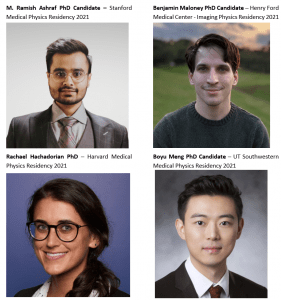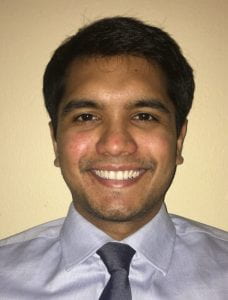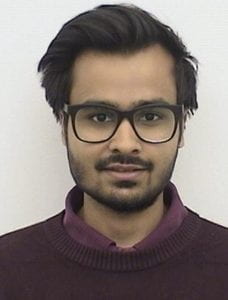Savannah Decker won the SLAM competition at the Winter meeting of the New England chapter of the American Association of Physicists in Medicine. This competition is to determine who can describe their research project in a clear concise manner that anyone can understand - in 3 minutes or less! Congratulations Savannah!
Category: News
Three Dartmouth researchers accepted for AAPM Early-Career Symposium
Three Dartmouth researchers involved in radiotherapy work have been accepted into the Early Career Investigator Symposium competition, in the American Association of Physicists in Medicine (AAPM) Spring Clinical Meeting. Dr. Daniel Alexander, and PhD Candidates Savannah Decker and Austin Sloop will present their research. The three talks are linked here: the program
| 10:30 AM | SA-B-Celestin-1 | |
| Saturday | Clinic-Wide Cherenkov Imaging Identifies New Areas of Quality Improvement in Radiation Therapy | |
| D.Alexander*, M.Jermyn, P.Bruza, R.Zhang, E.Chen, S.Decker, B.Pogue, L.Jarvis, D.Gladstone | ||
| 11:10 AM | SA-B-Celestin-5 | |
| Saturday | Automated Detection Algorithms for Improving Radiotherapy Delivery That Directly Quantify Treatment Errors From Online In Vivo Cherenkov Imaging | |
| S.Decker*, D.Alexander, P.Bruza, R.Zhang, E.Chen, L.Jarvis, D.Gladstone, B.Pogue | ||
| 11:50 AM | SA-B-Celestin-9 | |
| Saturday | Characterization of Newly Designed EDGE Detector for UHDR FLASH Radiotherapy | |
| A.Sloop*, M.Rahman, J.Kozelka, M.Ashraf, P.Bruza, D.Gladstone, B.Pogue, J.Kapatoes, W.Simon, R.Zhang |
Daniel Alexander defends Thesis and accepts residency at UPenn
Ph.D Candidate Daniel Alexander defended his thesis work, " Expanding Cherenkov Imaging Applications in Radiotherapy: Clinic-Wide In Vivo Treatment Monitoring and MR-Linac Quality Assurance" on November 3rd. Daniel graduates at the end of this Fall term and has accepted a residency program in therapeutic Medical Physics at the University of Pennsylvania to start in the spring. Congratulations Dr. Alexander!

Dartmouth Medical Physics PhD Program Graduates Select & Match into Residencies
Rachael Hachadorian Wins Nature Comm Essay Contest
PhD Candidate Rachael Hachadorian won the recent Nature Communications Essay content for early career applicants, associated with publications in the journal. Read all about her experiences here. Also find her scientific publication in the journal (Nature Comm. 11, 2298, 2020) here. She also successfully defended her PhD thesis on Friday March 19, 2021!
Three Dartmouth researchers accepted for AAPM Early-Career Symposium
Three Dartmouth researchers involved in radiotherapy work have been accepted into the Early Career Investigator Symposium competition, in the American Association of Physicists in Medicine (AAPM) Spring Clinical Meeting. PhD Candidates Mahbubur 'Ronny' Rahman and Daniel Alexander will present along with Thayer Research Scientist Brady Hunt PhD. The three talks are all at the start of the program, linked here:
| SA-B-Therapy Saturday | ||
| 12:30 PM | Clinical Treatment Planning System for Electron FLASH Radiotherapy
Mahbubur Rahman |
|
| 12:40 PM | MR-Linac Isocenter Coincidence Verification Using Cherenkov Imaging
Daniel Alexander MS |
|
| 12:50 PM | Gantry Motion Artifact Reduction Using Deep Learning: Towards Volumetric Modulated Arc Therapy On MR-Linacs
Brady Hunt PhD |
|
3D Shapes of Breast Cancers Mapped
In a study by Medical Physics PhD Candidate, Brook K Byrd, the three-dimensional shape of breast cancer was examined for the first time in a comprehensive study of 83 patients using supine MRI. As they describe, "implicit to approaches that localize the center of the tumor for breast-conserving surgery (BCS) of non-palpable cancers is the assumption that breast cancers are spherical about a central point, which may not be accurate." The team found that cancers could be categorized into four tumor shapes, with 34% discoidal, 29% segmental, 19% spherical & 18% irregular. They found that they could use these tumor shape models to better inform surgery, and potentially allow more precise resection. The work was published in Breast Cancer Research and Treatment Sept 2020. DOI: 10.1007/s10549-020-05780-6
CT number can be used to calibrate Cherenkov to Dose In Breast Radiotherapy
A recent study by Rachael Hachadorian and colleagues in Nature Communications (DOI https://doi.org/10.1038/s41467-020-16031-z), showed how the intensity of Cherenkov light coming from patients getting whole breast radiotherapy was affected by the tissue present. The CT scans of each patient were used to calibrate for attenuation of the light for fibroglandular versus adipose tissue variations, as a surrogate for blood based attenuation. The group showed that the calibrated Cherenkov was closer to a true representation of the average dose delivered to the breast, paving the initial step towards quantitative remote dose imaging in vivo.
Rachael Hachadorian, PhD candidate 2021
FLASH Radiotherapy Beam Created on Clinical Linac at Dartmouth-Hitchcock
A ‘FLASH’ ultra-high dose rate radiation therapy beam was initiated in New England for the first time, demonstrating that it can be achieved reversibly on a clinical linear accelerator, and deliver the beam in a standard patient geometry. The work was Reported in the IJROBP paper by PhD students Mahbubur Rahman and Ramish Ashraf (DOI: 10.1016/j.ijrobp.2021.01.011).
Mahburbur Rahman H. Ramish Ashraf
The work was done at the Norris Cotton Cancer Center (NCCC) by a joint team of researchers led by Professors David Gladstone, Rongxiao Zhang and Benjamin Williams from the Division of Radiation Oncology within the Department of Medicine, PhD students Ronny Rahman and Ramish Ashraf at the Thayer School of Engineering as well as Professors Petr Bruza and Brian Pogue, and Professor Jack Hoopes in the Department of Surgery, at Dartmouth-Hitchcock Medical Center in Lebanon NH. Pilot funding from the NCCC and Thayer provided the team with the capability to prototype how to convert linac to this exceptionally high dose rate of 300 Gray per second, whereas normal therapy treatment is done at 0.1 Gray per second. Instead of treatment over 20 seconds, an entire treatment is completed in 6 milliseconds. These high dose rates have been shown to protect normal tissues from excess damage while still having the same treatment effect on tumor tissues, and so may be critically important for limiting radiation damage in patients receiving radiation therapy. The work was reported Aug 16 2020 in the online arXiv publication arXiv:2008.06980 [physics.med-ph]. The team developed the beam for pre-clinical testing future human translational studies.
Dr David J. Gladstone, Sc.D. Elected Fellow of the American Association of Physics in Medicine
Head of Clinical Physics, David J. Gladstone Sc.D. has been elected as a Fellow of the American Association of Physics in Medicine (AAPM) at the annual meeting in July 2020.
Election to Fellowship in the AAPM signifies that the recipient has demonstrated excellence in Leadership to the Profession, Service to the AAPM, Research and Scholarly Work, or Teaching and Mentoring. The award of 'Fellow' designation is a significant honor within the society, indicating their work at the highest level of both their career work and to importance to the society.





